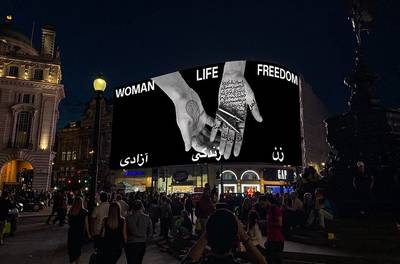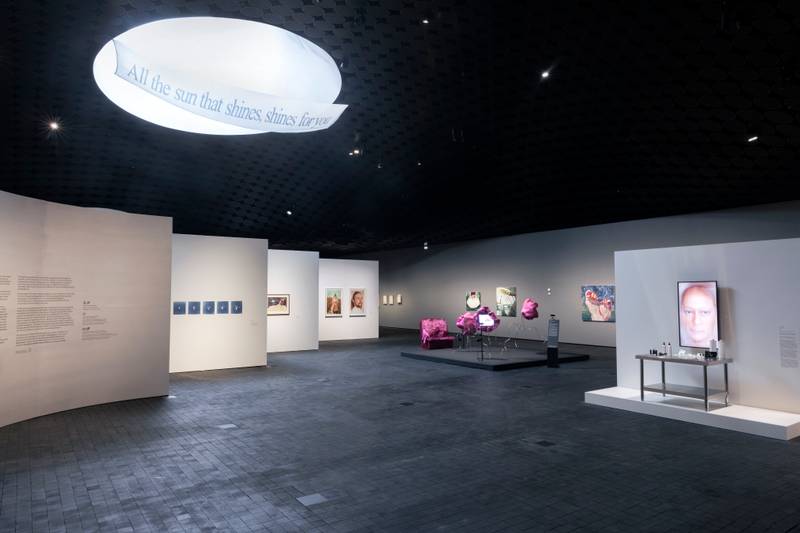

Generation 2023, Installation View, 2023, Image: Aleksi Poutanen
Jaakko Uoti works in the contemporary arts and as a freelance-writer and editor with a focus in art and visual culture. He’s the former editor in chief of the Finnish online cultural journal Mustekala.info. He holds MA degrees in art history and communication studies.
A bit over a week after the spring equinox, the third iteration of the Generation triennial, organised by Amos Rex, opened in Helsinki. Upon entering the underground main exhibition hall of the museum, I look up and am greeted by the words, “All the sun that shines, shines for you.” The words are printed on a white fabric that crosses over one of the museum’s signature big, round skylights. The statement is part of Veeti Otsamo’s series of cyanotypes1 that bears the same name. The work suggests that it is finally Spring: the season of light, promise, and potential.
Generation 2023 gives the spotlight to the work of artists aged between 15 and 23. With its opening date at the start of spring, Generation 2023 is lined up with many other group shows with long traditions of focusing on young artists: Kuvan Kevät (the MFA graduation show of the Academy of Fine Arts of Uniarts Helsinki) and several other art school graduation shows, as well as the Nuoret exhibition (the Young Artists exhibition showing artists under 35) organised by the Finnish Artists’ Association.
Usually, young artists’ exhibitions present artists who are at the beginning of their professional careers or graduating from art school. The Generation Triennial, established in 2017, goes even younger with its focus on artists in their teens and early adulthood. The cultural interest in youth has always been double-edged: the young are both idolised and moralised - they are viewed as full of promise and potential for making a change in the world - changes the previous generations perhaps no longer see themselves as capable of pushing for - but also as terrors and indicators of what is wrong with the current culture. The art world has its own ghost of the enfant terrible, the successful, brash, and unconventional young artist closely related to the artistic genius.
The love-hate relationship with youth, combined with the art world’s urge to always find the next new thing and benefit from it, can create an exploitative undertone to exhibitions of young artists. In the art market, artists are often highly valued as new finds and emerging artists and then later again as established art stars and old masters (especially after the artist has passed away). The middle part, when most of the actual artistic work is done and the oeuvre is formed, might not be so exciting, at least for the media and auction houses.
It feels that the Generation triennial’s focus on 15-23 year-olds (a tight age range of nine years) does not have that much to do with trying to push new artists to the market, but rather with the museum wanting to create a triennial of their own invention and branding, tapping into a new undiscovered demographic in the Finnish contemporary art world: a pool of young people with artistic ambitions who have not been fully formed in art schools and are not exhibited much elsewhere.
As is often the case with young artists’ group exhibitions, in Generation 2023 there is no strong curatorial focus. This is understandable if the starting point is as arbitrary as being roughly the same age or being in the same graduating class at an art school. Thus, the curation of these types of group shows tends to lean toward showcasing diversity (of themes, media, artistic thinking, or whatever it may mean in each case). In Generation 2023, hints of generational experiences are also present.
In the texts accompanying the exhibition, a lot of emphasis is put on the artists’ multidisciplinary practices, overall diversity, and varied backgrounds. “The life experiences of this generation” and “their reflections on the current state of the world” are said to play a key role. Looking at the long list of 50 participating artists or working groups, it seems that diversity in terms of background, gender, and nationality has been taken into account in the curation. Issues such as the questioning of gender norms and appearance, identity, digital exhaustion, and worry about the state of nature are also listed as examples of issues that the artists deal with in their work.2 The topics highlighted are often associated with Gen Z, or Zoomers, the generational category into which the exhibited artists also fall.
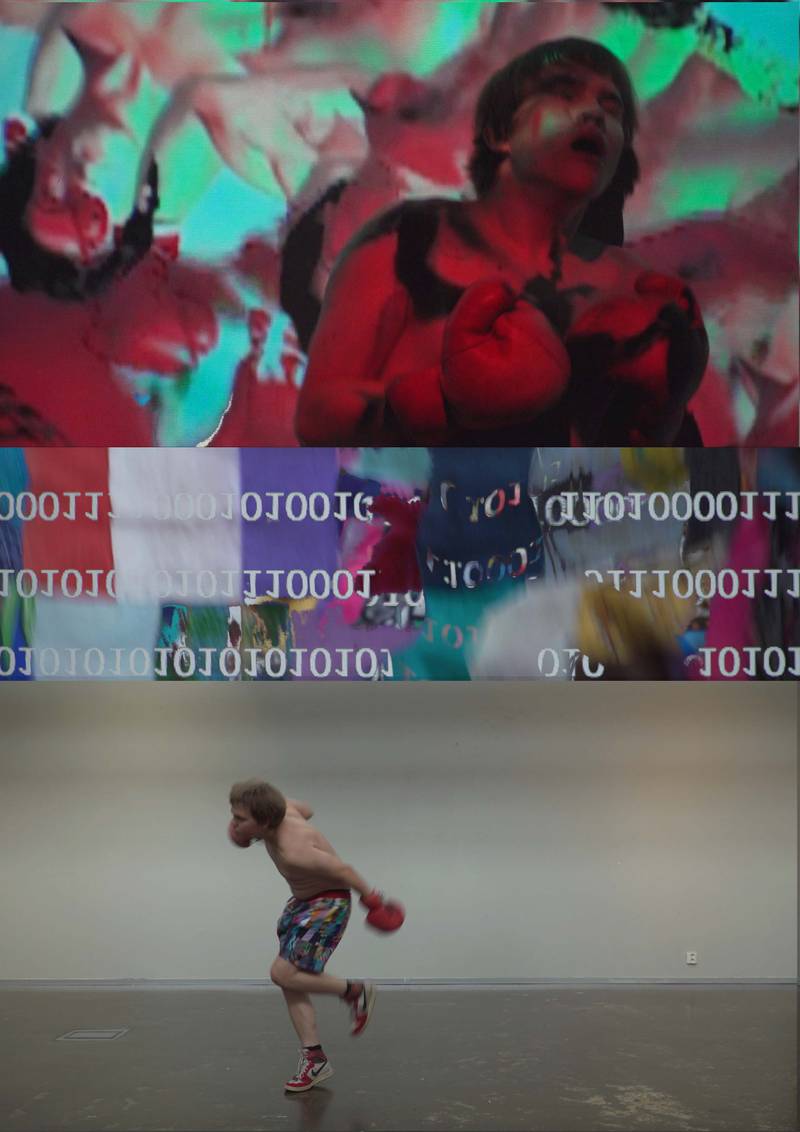

Aatos Ketvel, The Rocky Balboa Gender Show, 2023, Image: Valo Rinne
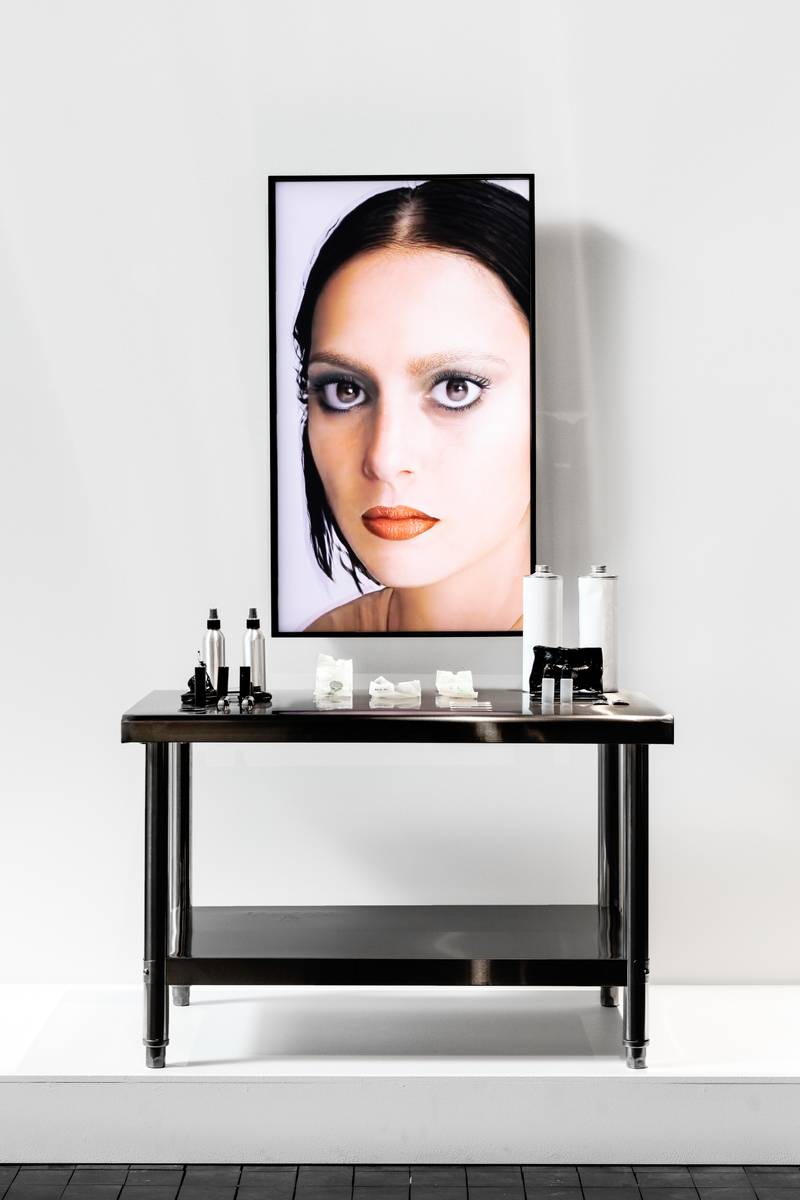

Juho Lehiö, Face: to put on a face, to remove a face, 2023, Image: Stella Ojala
Identity is also often at the forefront of young artists’ exhibitions, as art critic Sanna Lipponen notes in her review of the latest Nuoret exhibition in Helsingin Sanomat.3 Writer Aino Frilander also puts identity formation at the forefront in her review of Generation 2023, also published in Helsingin Sanomat.4 Identity also pops up in the museum’s own curatorial discourse.
The questions of identity as well as digital media, two typically Zoomer-y tropes, are, without a doubt, visible in many of the works. The exhibition opens with a space featuring two moving image works that explore identity and self-representation in very direct ways. Juho Lehiö’s interactive installation Face: to put on a face, to remove a face that addresses the use of filters and self-photography in the form of a makeup station with molten plastic make up gear as well as surgical equipment and a video in place of the stream of AI-generated faces in a looping sequence - a mix that flattens the differences of cosmetic, digital, and surgical enhancements. Aatos Ketvel’s The Rocky Balboa Gender Show is a video installation based on the artists’ gender performance that they have developed to problematize the masculine performance of Rocky movies. Filters and self-representation on social media are also explored later in Juulia Vanhatalo’s video Filter, where the artist performs a simple performance utilising Photoshop as a make-up kit. The soundtrack, which is just the dull hum of the projector, completes the deadpan delivery. The question of identity does surface, and it is also put into focus, but I would argue that this probably comes rather from the fact that youth is commonly the time of identity formation in peoples’ lives, not because it is the most interesting connecting thread of the show or even the most common theme among the works.
The good side of any sprawling group exhibition is that, in its vastness, everyone can find their own path in the show. Also, one can think of this kind of somewhat vague curatorial discourse as something that is meant to be taken lightly.
The question of identity does surface, and it is also put into focus, but I would argue that this probably comes rather from the fact that youth is commonly the time of identity formation in peoples’ lives, not because it is the most interesting connecting thread of the show or even the most common theme among the works.
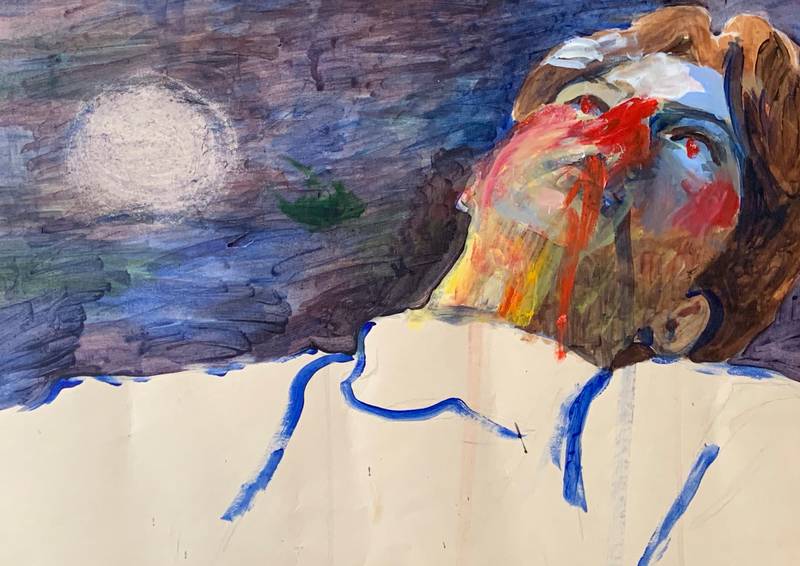

Emma Oittinen, Kerran Kuun Kiertoon, 2023, Image: Stella Ojala
I notice that my focus as the viewer is drawn to works that do not tick the usual Zoomer boxes of a technology and identity obsessed generation, maybe in a conscious effort to resist the most obvious narratives. Apart from works using digital media, there are a lot of technically skilled paintings in the exhibition that open up themes of identity and self-representation in distinctive ways; Emma Oittinen, Mariia Sennikova, and Johanna Saikkonen’s portraits, for instance. Perhaps not loud and brash, but poignant and intimate. In large group exhibitions, fairly muted works stand-out for me, like the aforementioned minimalistic work by Veeti Otsamo, who also shows a series of colour photographs of simple structures built from household objects.
Along the same lines of resisting the idea of young artists being interested in only trendy topics, I notice that my interest is drawn to works that make use of non-contemporary media. In the exhibition, several interesting explorations of traditional handicrafts such as ryijy5, weaving, and other textile techniques are also to be found. Ida Tomminen’s work Botanical Excellence comments on our relationship with nature in a rough and tactile manner, presenting a man-made turf carpet reminiscent of cosy Finnish summer cabin decor and synthetic AstroTurf. One pleasant surprise and a personal highlight of the show for me was Axel Lyytikkä’s exploration of the Greek-Roman amphora, which combines 3D-printing and ancient ceramics. I think that in both cases, the artists have succeeded in exploring tradition and art history deeper than surface level, in a way that is rooted in artistic work, of experiencing through different materials, textures and space. Also the marriage between the old and the new seems seamless and not forced.
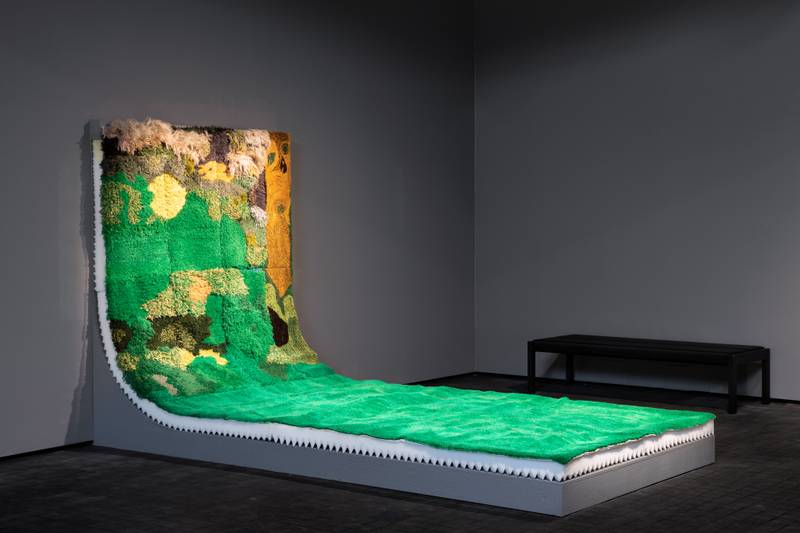

Ida Tomminen, Botanical Excellence, 2023, Image: Aleksi Poutanen
Giving artists between the ages of 15 and 23 the opportunity to participate in a group show at a major museum and exhibit their work to a large audience is quite unusual — not that showing your work at Amos Rex would be accessible for many professional artists with long careers, either.
Allowing people outside of art schools or other institutional frameworks to exhibit their work has the potential to open the art world a little bit more to artists outside the higher education system and from underprivileged positions. The exhibition concept also allows the participation of creatives who are working in between genres and media, perhaps even people who may not even perceive themselves as artists.
In the end result, this openness to diversity is somewhat visible in the artists’ backgrounds and media, for instance, in the way textile art, comics, and animation, as well as performing arts, are added into the mix, but otherwise, the look and feel of the show is that of a quite traditional, high production value museum exhibition that is not pushing a lot of boundaries. There are really no enfants terribles here. The raging against the machine mentality that is often visible in art school graduation shows is not present in Generation 2023. Obviously, art students often have a long and more vivid relationship with their alma mater, and that shows partly in their graduation exhibitions, in a sense of rebellion against the institution. However, it is still worthwhile to ponder why the exhibition somehow seems tame. Some social issues are addressed, but in a fairly polite and non-disruptive way. One possibility is that the young artists calibrate their work to fit the surrounding institution and its prestige. Perhaps there is also a hope to appear mature and to produce art that feels and looks like contemporary art that is usually exhibited in a museum.
Amos Rex is still known for its flashy new museum building and well-resourced hit exhibitions. Generation 2023 is no different from Amos Rex’s blockbuster exhibitions in terms of layout and production. The sprawling exhibition has many great works, and they are presented in a stylish and easily accessible package. On the other hand, it is gratifying that young artists are treated equally and that the high quality of the museum’s production extends to them as well. On the other hand, the museum has not deviated from its usual sleek lines. The exhibition simply follows the museum’s own standard: creating a high production value exhibition that seems cool and sleek enough in its design choices but rather conservative in the way the artworks are exhibited.
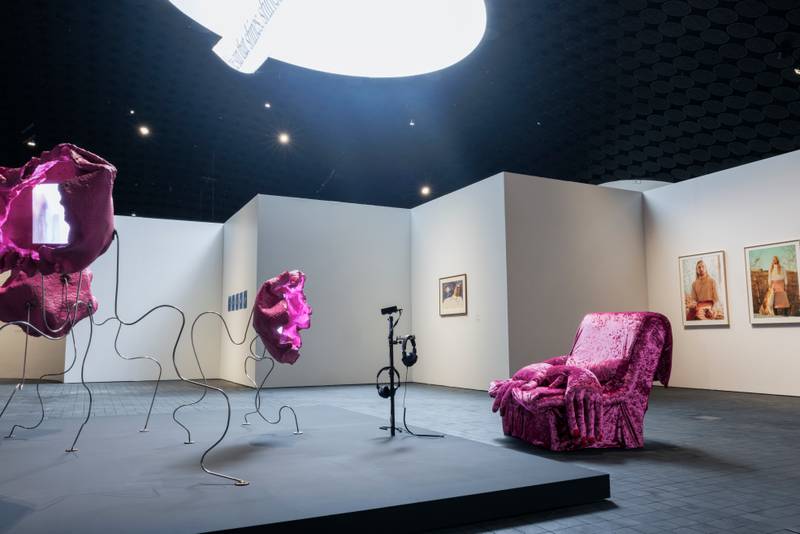

Generation 2023, Installation View, 2023, Image: Aleksi Poutanen
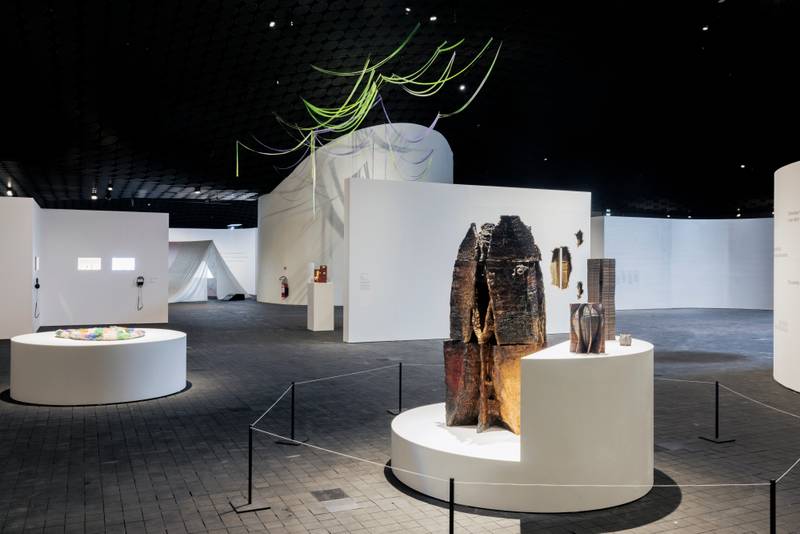

Generation 2023, Installation View, 2023, Image: Aleksi Poutanen
Knowing the often dire working conditions of visual artists, I cannot shake the thought that Generation invests heavily in very young non-professional artists who may not even be that invested in the art world, while many older professional artists struggle with everyday working life and have perhaps never been given the same amount of support and resources as these newcomers. I’ve heard a lot of criticism over the years from several professional artists regarding the Generation Triennial: when the art world seems to already be obsessed with tapping into new talent, why must we go even younger when many mid-career artists and older artists seem to fall into oblivion?
Sour grapes? Maybe for some, but even so, I understand these sentiments. There has been a conscious pedagogical approach on the part of the museum and the curators.6 In the context of Generation 2023, apart from providing a platform for the artists, the museum has handed out grants, given the artists support in grant application processes, and created opportunities to access residencies and studio spaces, not to mention the role of a big museum’s professional technical team. The young ones have been well taken care of, maybe in a way that does not seem deserved from the point of view of artists who have scraped by for years and years in their careers.
The visual arts are the least developed of all the different artistic disciplines in Finland in terms of organisation, support structures, and, for example, employment contracts. These developments are necessary, but their focus on young artists can give the impression that only young people need special support - it is more about the fact that the whole sector of visual arts in Finland is in many ways still in its infancy when it comes to building a healthy and sustainable working environment.
Offering resources for artists to produce work and present it to the public is essential for encouraging younger people to pursue artistic practices as a career path. In the context of this year’s Nuoret exhibition, salaried working models for a selection of the exhibited artists have been introduced to tackle the precarious working conditions of artists.7 These are all awaited actions to take in a field known for its precarity and lack of labour structures and regulation. The visual arts are the least developed of all the different artistic disciplines in Finland in terms of organisation, support structures, and, for example, employment contracts. These developments are necessary, but their focus on young artists can give the impression that only young people need special support - it is more about the fact that the whole sector of visual arts in Finland is in many ways still in its infancy when it comes to building a healthy and sustainable working environment. Hopefully, these models are implemented more commonly for artists of all ages, not just young newcomers.
In the context of the museum’s program, which creates a young artists’ triennial of their own, I believe Amos Rex handily also makes use of Generation as a way of complementing their otherwise fairly conventional exhibition programming that relies on big art world names. Amos Rex exhibitions usually feature mid to late-career or canonised Western artists, often outright stars of the art world such as Bill Viola, Hans Op de Beeck, or one of the modernist artists, René Magritte. Generation 2023, like any exhibition that promises diversity or representation of an otherwise marginalised group, can be read as a performative gesture of outsourcing diversity to young artists who encompass both a younger age group as well as representing diverse nationalities, genders, and ethnicities.
Young people are also notoriously difficult for museums to reach, but they are a desirable target group. I presume that one of the Generation exhibitions’ aims is to reach younger visitors by showcasing young artists. The majority of museum visitors in Finland are middle-aged or at least over 30 years old, with the lowest number of visits in the under 24 age group (although many museums offer free admission for visitors under 18 or reduced tickets for visitors under 30 and students).8 It would be interesting to know if an exhibition of young artists appeals to the same demographic of potential visitors. As a former young person, I recall that back in the day, I would have probably rejected any programming that was supposed to appeal to my own age group.




